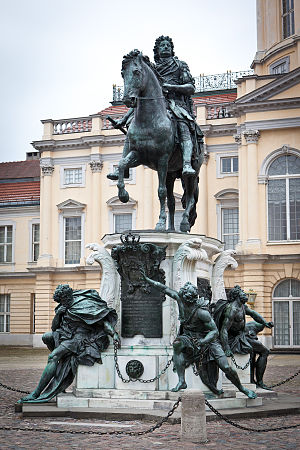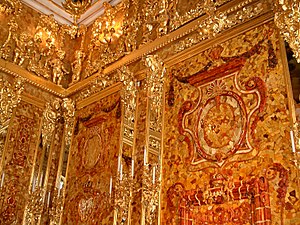Andreas Schlüter




Andreas Schlüter (1659 – c. June 1714)
Biography
Andreas Schlüter was born probably in
He probably did spend several years abroad as
Schlüter's first known work was the decoration of the facade of the Danzig Royal Chapel, in 1681. He later created statues for King John III Sobieski's Wilanów Palace in Warsaw and sepulchral sculptures in Zhovkva. In 1689, he moved to Warsaw and made the pediment reliefs and sculptural work of Krasiński Palace.
Schlüter was invited to
Schlüter also worked as an architect and built many state buildings in Berlin in his role as "Hofbaumeister" (Court Architect), which he lost when one tower showed signs of a weak fundament. He also served as director of the
The Berlin City Palace, and many of his works, were partially destroyed by bombing in
In 1713, Schlüter's fame brought him to work for Tsar
Extant works
- Facade of the Royal Chapel, Gdańsk, 1681
- Sculptures on the facade of Wilanów Palace, Warsaw, after 1681
- Sculptures on the pediment of Krasiński Palace, Warsaw, 1682–83, 1689–1693
- Epitaph of Adam Zygmunt Konarski, St. Mary's Cathedral of the Assumption, Frombork near Gdańsk, after 1683
- Altar and crucifix in church, Węgrów near Warsaw, 1688–1690
- Altar in Czerniaków church, Warsaw, 1690
- Portrait bishop Jan Małachowski in Wawel Cathedral, Kraków 1693
- Aepulchral sculptures of the , 1692–93
- Equestrian statue of Elector Bode-Museum
- Sculptures on the facade of the Zeughaus in Berlin, 1695–1706
- Berlin Palace, 1699–1706
- , 1701
- Pulpit, St. Mary's Church, Berlin, 1703
- Sarcophagi of Friedrich I and Sophia Charlotte, King and Queen in Prussia in the Berlin Cathedral
References
- ^ Biographie, Deutsche. "Schlüter, Andreas - Deutsche Biographie". www.deutsche-biographie.de (in German).
- ^ nach älteren Quellen angeblich am 20. Mai 1664 in Hamburg als Sohn des Bildhauers Gerhart Schlüter geboren – Andreas Schlüter, in: Allgemeine Deutsche Biographie (ADB). Bd. 55, Leipzig 1910, S. 184–194.
- ^ Gallery Archived 21 December 2003 at the Wayback Machine
External links
- . Encyclopedia Americana. 1920.
- . Encyclopædia Britannica. Vol. 24 (11th ed.). 1911. p. 343.
- Nicolai, Bernd (2007), "Schlüter, Andreas", Neue Deutsche Biographie (in German), vol. 23, Berlin: Duncker & Humblot, pp. 111–113; (full text online)
- Bruck, Robert (1910), "Andreas Schlüter", Allgemeine Deutsche Biographie (in German), vol. 55, Leipzig: Duncker & Humblot, pp. 184–194
- Biography, by Heinz Ladendorf, 1935
- Article in Morgenpost newspaper
- dhm.de: Schlüter bio at Zeughaus
- English site about Kikin's Palace (Mansion House)
